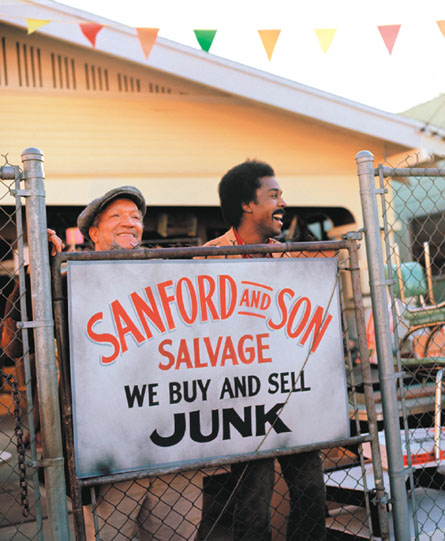 Browns Archive
Browns Archive  Sanford and Son, NFL-Style
Sanford and Son, NFL-Style
It’s early March on the NFL calendar which can only mean one thing: the world’s costliest flea market is open for business, limited time only.
Every year beginning in late February, just after the NFL combine closes and general managers and coaches have had their fill of poking, prodding and testing the new meat, each NFL team heads to the fair grounds and sets up a swap meet of sorts to poke, prod and test the old meat.
 Each booth features a team’s cast offs in the form of restricted and unrestricted free agents just looking for a new buyer. And as these teams are arranging their slightly-worn trinkets just so, they’re also gazing out at what’s going on in the other booths. Sure, I don’t need this lamp shaped like a bowling pin anymore but that picture of dogs playing cards over in the next booth would look great in the den.
Each booth features a team’s cast offs in the form of restricted and unrestricted free agents just looking for a new buyer. And as these teams are arranging their slightly-worn trinkets just so, they’re also gazing out at what’s going on in the other booths. Sure, I don’t need this lamp shaped like a bowling pin anymore but that picture of dogs playing cards over in the next booth would look great in the den.
Welcome to Sanford and Son, NFL-style.
The Cleveland Browns aren’t any different than any other team. After carefully setting out their white elephants like Rex Hadnot, Hank Fraley, Brodney Pool, Jerome Harrison, among others, they’ve gone shopping for someone else’s gently-worn gems in the form of unrestricted free agent linebacker Scott Fujita and offensive lineman Tony Pashos. And they may not be done shopping, given the relative lack of furniture in their house.
This isn’t a knock on either Fujita or Pashos. Indeed both are upgrades for this team in the way that a full size mattress is an upgrade from a twin. But isn’t it just fascinating to watch year after year teams tire of players and cast them adrift only to see other teams become absolutely giddy at the chance to sign them?
In one sense, this can be attributable to teams using free agency to either rebalance or paper over the sins of the past. If a team has too many linebackers and not enough defensive backs, free agency gives it a chance to correct the disparity. If a team consistently drafts poorly in the second round and finds itself with gaping holes in key spots, free agency affords a chance to catch up with the pack.
But more often than not, free agency is far more about teams not wanting to overpay their current players so that they can overpay someone else’s.
Fujita is a good example. From a personal standpoint, he’s a class act, a pillar of the New Orleans community, the kind of guy any team should want on its roster. From a player perspective, he’s 31 years old in a league where players usually have a shelf life of about 5 good years and making too much money, at least from the Saints’ perspective. In other words, speaking strictly from a production standpoint, the Saints feel they have younger players making less money that can produce a roughly the same level. They’d rather use his money to potentially overpay someone else, such as a draft pick who’s yet to prove himself.
The Browns, on the other hand, aren’t so lucky. Sure, they have younger players. But stacked end to end these players can’t produce at roughly the same level Fujita projects for the next few seasons. Indeed, even though the young linebackers on this team chew up less salary than Fujita will be making, the drop off in production is too dramatic. Hence Fujita becomes a member of the Browns and general manager Tom Heckert can sing the praises of how a linebacker whose been productive in the 4-3 defense can suddenly be that missing inside presence in the Browns’ 3-4 scheme.
Pashos is in exactly the same spot except that he leaves a team in the San Francisco 49ers with nearly as many problems as the Browns. Indeed, if you follow Pashos’ career, he’s come from mostly marginally productive offenses in both Baltimore and Jacksonville as well.
This is the part of free agency that actually worries me. When a team like the Browns signs a player from a team with as many issues, I’m suspicious. I don’t need to look at the stats to know that the 49ers can’t possibly have a plethora of offensive linemen that can easily replace Pashos unless they are of the “can’t be any worse” variety. When I look at the stats, I become truly convinced.
The 49ers weren’t a rushing team last year, averaging just 23 attempts per game as compared to Cleveland’s 31. With similar yards/carry averages, the number of attempts accounts for the fact that the Browns averaged 30 more rushing yards per game than the 49ers.
When I look at the 49ers passing statistics, they were a fourth quartile team, just like the Browns. Sure, the Browns were at the bottom of the league when it came to passing, but the 49ers weren’t lighting it up, either.
All of this is a circuitous way of getting to the point that the 49ers themselves could use help on the offensive line, just like the Browns, and they don’t see Pashos as part of that process. They may be lacking in skill players, such as at quarterback and receiver, just like the Browns, but as we’ve seen in Cleveland when the offensive line plays well even Derek Anderson can be a Pro Bowler.
This makes me even more suspicious about Pashos except that I remember that the Browns still have Floyd Womack and John St. Clair anchoring, as it were, the right side of the offensive line and can’t help but think that Pashos has to be an upgrade, he just has to be.
The missing variable in all of this Pashos’ contract with the Browns. Unlike Fujita’s $16 million/3 year/$8 million guaranteed contract, I haven’t seen much said about Pashos’ contract. That means it’s either bigger than it has to be, which would be embarrassing to the Browns, or smaller than Pashos and his agent would like it known.
 But this is the minor stuff. The real splash at the swap meet will be coming in the form of a new quarterback. Team president Mike Holmgren has said he’s still evaluating both Anderson and Brady Quinn but he’s also been quite candid in saying that he’s also looking elsewhere. That elsewhere will take up one of two forms: a veteran to help mentor Quinn or an up and comer to take over the team.
But this is the minor stuff. The real splash at the swap meet will be coming in the form of a new quarterback. Team president Mike Holmgren has said he’s still evaluating both Anderson and Brady Quinn but he’s also been quite candid in saying that he’s also looking elsewhere. That elsewhere will take up one of two forms: a veteran to help mentor Quinn or an up and comer to take over the team.
When I heard the Browns were interested in David Carr, the veteran-as-mentor concept seemed clear. Among the many problems with having both Anderson and Quinn on the roster is that both are still learning the position and are backed up by someone even more green in the form of Brett Ratliff. Having someone with significant NFL experience on the sidelines to back up someone still learning the position has always made more sense.
But then the Browns traded for Seneca Wallace, the back up in Seattle. That just muddles the situation even further but probably means Quinn will be traded along with Anderson and the Browns will then still be searching for a veteran quarterback to serve as a back up.
I can’t quite determine why the Browns would want Wallace. He’s a 29-year old, 5’11” career backup. Think Troy Smith without the Heisman. Five years in the league, he has exactly 12 starts under his belt, or exactly 20 less than Holmgren says are necessary for a proper evaluation.
It seems reasonable that the Browns obtained Wallace with the intent to give him those 20 additional starts because he’s certainly not at that stage of his career or his development where he can mentor anyone. Having made the trade, though, it also tells you plenty about what the Seahawks think of Wallace's chances as a long-term starter, which is something to chew on as well.
Which takes us right back to where we started, scouring the flea market for a priceless or at least pricey antique masquerading as a piece to tchotchke.
As a long-term strategy, it’s flawed. Just as the Indians’ Mark Shapiro whose used the strategy for years to little effect. For now, hope that it’s being used here only because the options are so otherwise limited and not because it’s a case of “meet the new boss, same as the old boss.”
- NBA Announces 2013-2014 Schedule
- Browns Ink Sharknado
- Sharknado A No-Show For Rookie Camp
- Trent Richardson Out Until Training Camp
- Browns Sign Brandon Jackson
- Carrasco Suspended Eight Games
- Browns Add to Wide Receiver Depth with David Nelson
- Browns Need to Learn from Past Draft Mistakes
- Browns Release Chris Gocong and Usama Young
- Browns Missing on Grimes Disappointing, But Not The End
The TCF Forums
- Movies coming out
rebelwithoutaclue (Tuesday, January 21 2014 12:56 PM) - 2015 Recruiting
jclvd_23 (Tuesday, January 21 2014 12:38 PM) - The 2014 Offseason Thread
Larvell Blanks (Tuesday, January 21 2014 12:25 PM) - Official- Browns Coach Search/Rumors
Larvell Blanks (Tuesday, January 21 2014 11:53 AM) - Chris Grant's first 3 drafts
Kingpin74 (Tuesday, January 21 2014 10:13 AM) - Mike Brown
YahooFanChicago (Monday, January 20 2014 11:15 PM) - 2014 Hoops Hockey Hijinx
jpd1224 (Monday, January 20 2014 4:44 PM) - 2014 Recruiting
jclvd_23 (Monday, January 20 2014 2:26 PM) - Wish List - #4 Pick
Hikohadon (Monday, January 20 2014 1:26 PM) - #1 overall pick Anthony Bennett
TouchEmAllTime (Sunday, January 19 2014 1:28 PM)


